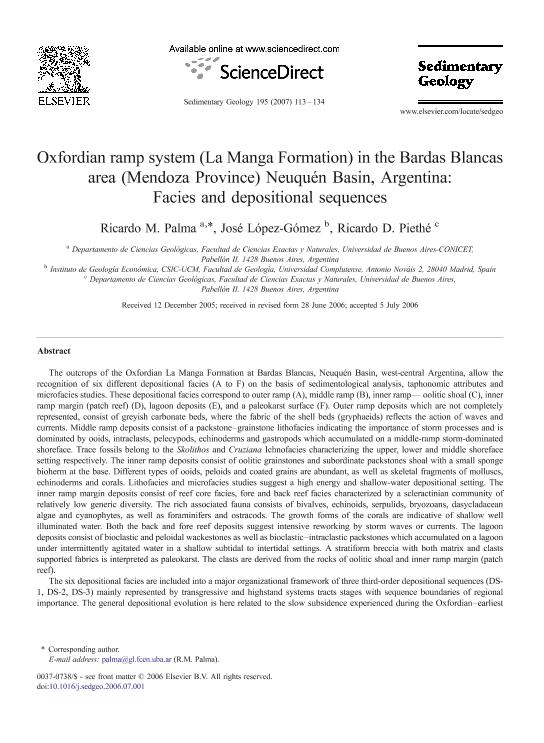Mostrar el registro sencillo del ítem
dc.contributor.author
Palma, Ricardo Manuel

dc.contributor.author
López Gómez, José
dc.contributor.author
Piethé, Ricardo D.
dc.date.available
2019-12-23T13:36:34Z
dc.date.issued
2007-03
dc.identifier.citation
Palma, Ricardo Manuel; López Gómez, José; Piethé, Ricardo D.; Oxfordian ramp system (La Manga Formation) in the Bardas Blancas area (Mendoza Province) Neuquén Basin, Argentina: Facies and depositional sequences; Elsevier Science; Sedimentary Geology; 195; 3-4; 3-2007; 113-134
dc.identifier.issn
0037-0738
dc.identifier.uri
http://hdl.handle.net/11336/92731
dc.description.abstract
The outcrops of the Oxfordian La Manga Formation at Bardas Blancas, Neuquén Basin, west-central Argentina, allow the recognition of six different depositional facies (A to F) on the basis of sedimentological analysis, taphonomic attributes and microfacies studies. These depositional facies correspond to outer ramp (A), middle ramp (B), inner ramp- oolitic shoal (C), inner ramp margin (patch reef) (D), lagoon deposits (E), and a paleokarst surface (F). Outer ramp deposits which are not completely represented, consist of greyish carbonate beds, where the fabric of the shell beds (gryphaeids) reflects the action of waves and currents. Middle ramp deposits consist of a packstone-grainstone lithofacies indicating the importance of storm processes and is dominated by ooids, intraclasts, pelecypods, echinoderms and gastropods which accumulated on a middle-ramp storm-dominated shoreface. Trace fossils belong to the Skolithos and Cruziana Ichnofacies characterizing the upper, lower and middle shoreface setting respectively. The inner ramp deposits consist of oolitic grainstones and subordinate packstones shoal with a small sponge bioherm at the base. Different types of ooids, peloids and coated grains are abundant, as well as skeletal fragments of molluscs, echinoderms and corals. Lithofacies and microfacies studies suggest a high energy and shallow-water depositional setting. The inner ramp margin deposits consist of reef core facies, fore and back reef facies characterized by a scleractinian community of relatively low generic diversity. The rich associated fauna consists of bivalves, echinoids, serpulids, bryozoans, dasycladacean algae and cyanophytes, as well as foraminifers and ostracods. The growth forms of the corals are indicative of shallow well illuminated water. Both the back and fore reef deposits suggest intensive reworking by storm waves or currents. The lagoon deposits consist of bioclastic and peloidal wackestones as well as bioclastic-intraclastic packstones which accumulated on a lagoon under intermittently agitated water in a shallow subtidal to intertidal settings. A stratiform breccia with both matrix and clasts supported fabrics is interpreted as paleokarst. The clasts are derived from the rocks of oolitic shoal and inner ramp margin (patch reef). The six depositional facies are included into a major organizational framework of three third-order depositional sequences (DS-1, DS-2, DS-3) mainly represented by transgressive and highstand systems tracts stages with sequence boundaries of regional importance. The general depositional evolution is here related to the slow subsidence experienced during the Oxfordian-earliest Kimmeridgian time related to tectonic inversion in the Neuquén Basin. A four step (architectural and sedimentary) schematic model of the response of the platform to sea-level changes is proposed.
dc.format
application/pdf
dc.language.iso
eng
dc.publisher
Elsevier Science

dc.rights
info:eu-repo/semantics/openAccess
dc.rights.uri
https://creativecommons.org/licenses/by-nc-sa/2.5/ar/
dc.subject
DEPOSITIONAL SEQUENCE
dc.subject
FACIES
dc.subject
JURASSIC
dc.subject
LA MANGA FORMATION
dc.subject
NEUQUÉN BASIN
dc.subject
OXFORDIAN
dc.subject.classification
Geología

dc.subject.classification
Ciencias de la Tierra y relacionadas con el Medio Ambiente

dc.subject.classification
CIENCIAS NATURALES Y EXACTAS

dc.title
Oxfordian ramp system (La Manga Formation) in the Bardas Blancas area (Mendoza Province) Neuquén Basin, Argentina: Facies and depositional sequences
dc.type
info:eu-repo/semantics/article
dc.type
info:ar-repo/semantics/artículo
dc.type
info:eu-repo/semantics/publishedVersion
dc.date.updated
2019-11-08T15:15:43Z
dc.journal.volume
195
dc.journal.number
3-4
dc.journal.pagination
113-134
dc.journal.pais
Países Bajos

dc.journal.ciudad
Amsterdam
dc.description.fil
Fil: Palma, Ricardo Manuel. Consejo Nacional de Investigaciones Científicas y Técnicas. Oficina de Coordinación Administrativa Ciudad Universitaria. Instituto de Estudios Andinos "Don Pablo Groeber". Universidad de Buenos Aires. Facultad de Ciencias Exactas y Naturales. Instituto de Estudios Andinos "Don Pablo Groeber"; Argentina
dc.description.fil
Fil: López Gómez, José. Universidad Autónoma de Madrid; España
dc.description.fil
Fil: Piethé, Ricardo D.. Universidad de Buenos Aires. Facultad de Ciencias Exactas y Naturales. Departamento de Ciencias Geológicas; Argentina
dc.journal.title
Sedimentary Geology

dc.relation.alternativeid
info:eu-repo/semantics/altIdentifier/doi/http://dx.doi.org/10.1016/j.sedgeo.2006.07.001
dc.relation.alternativeid
info:eu-repo/semantics/altIdentifier/url/https://www.sciencedirect.com/science/article/abs/pii/S0037073806001990
Archivos asociados
